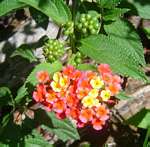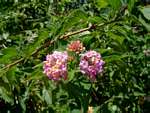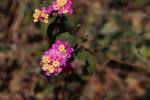Lantana camara
Selected images: Click on each image to see a larger version and details of the record View all images (30)
Detailed records: Display species records QDS maps by: Google Maps Point records by Google Maps
Species details: Click on each item to see an explanation of that item (Note: opens a new window)
| Synonyms: | |
| Common names: | Cherry pie (English) Lantana (English) Mbarapati (Shona) Ubuhobe besikhiwa (Ndebele) |
| Frequency: | Abundant |
| Status: | Introduced |
| Description: |
Aromatic shrub. Stems usually with numerous recurved prickles but these sometimes very sparse or even 0. Leaves opposite. Flowers in heads, 2-3 cm in diameter. Bracts of the inflorescence linear to linear-lanceolate, up to 2 mm wide. Corolla colours very varied. Fruit a fleshy purple or black drupe. |
| Type location: |
|
| Notes: | This species often forms impenetrable thickets to the exclusion of most other vegetation and become an aggressive invader of disturbed and overgrazed areas, which is difficult to eradicate. In the Flora of Tropical East Africa, Verdcourt separates L. camara from all the other species by possessing a stem with recurved prickles although he does note that the prickles may be sparse or even absent. In the FTEA description, Verdcourt notes that the flower colour may be "red, purple, pink, with yellow centre, salmon, orange, pure yellow, white etc. sometimes the inner flowers a different colour from the outer". We certainly see a great variety of colours around Harare and all these plants, provided they have prickly stems, are therefore cultivars of L. camara. |
| Derivation of specific name: | |
| Habitat: | In woodland, disturbed ground and in formerly cultivated areas, sometimes forming dense thickets. Spread by birds eating the black fleshy fruit. |
| Altitude range: (metres) | Up to 2000 m |
| Flowering time: | All year |
| Worldwide distribution: | Probably native of the West Indies, but well naturalised throughout the tropics and subtropics. |
| FZ divisions: | N,W,C,E,S |
| Growth form(s): | Shrub over 2 m, shrub under 2 m. |
| Endemic status: | |
| Red data list status: | |
| Insects associated with this species: | Acherontia atropos (Food plant) Oedicentra albipennis (Larval foodplant) |
| Spot characters: | Display spot characters for this species |
| Images last updated: | Thursday 12 April 2007 |
| Literature: |
Bandeira, S., Bolnick, D. & Barbosa, F. (2007). Wild Flowers of Southern Mozambique Universidade Eduardo Mondlane, Maputo, Mozambique Page 174. (Includes a picture). Baumann, G. (2005). Photographic Guide to Wildflowers of Malawi Wildlife and Environmental Society of Malawi Pages 142 - 143. (Includes a picture). Burrows, J.E., Burrows, S.M., Lötter, M.C. & Schmidt, E. (2018). Trees and Shrubs Mozambique Publishing Print Matters (Pty), Cape Town. Page 832. (Includes a picture). Chapano, C. & Mugarisanwa, N.H. (2003). Plants of the Matobo District National Herbarium and Botanic Garden, Zimbabwe Page 23. Drummond, R.B. (1975). A list of trees, shrubs and woody climbers indigenous or naturalised in Rhodesia. Kirkia 10(1) Page 271. Fernandes, R. (2005). Verbenaceae Flora Zambesiaca 8(7) Pages 17 - 19. Mapaura, A. & Timberlake, J. (eds) (2004). A checklist of Zimbabwean vascular plants Southern African Botanical Diversity Network Report No. 33 Sabonet, Pretoria and Harare Page 82. Ntore, S. & al. (2024). Checklist of the vascular plants of Burundi Page 239. Pickering, H. & Roe, E. (2009). Wild Flowers of the Victoria Falls Area Helen Pickering, London Page 114. (Includes a picture). Setshogo, M.P. (2005). Preliminary checklist of the plants of Botswana. Sabonet Report no. 37. Sabonet, Pretoria and Gaborone Page 110. Shone, D.K. & Drummond, R.B. (1965). Poisonous Plants of Rhodesia Ministry of Agriculture, Rhodesia Pages 56 - 58. (Includes a picture). Wild, H. (1955). Common Rhodesian Weeds Government of Rhodesia, Salisbury Page 101. (Includes a picture). Zende, M., Kativu, S. & Mhlanga, L. (2017). Impact of Lantana camara on vegetation, primary productivity and soils at Imire Ranch, Zimbabwe. Kirkia 19(1) Pages 101 - 109. |
Other sources of information about Lantana camara:
Our websites:
Flora of Botswana: Lantana camaraFlora of Burundi: Lantana camara
Flora of the DRC: Lantana camara
Flora of Malawi: Lantana camara
Flora of Mozambique: Lantana camara
Flora of Rwanda: Lantana camara
Flora of Zambia: Lantana camara
Flora of Zimbabwe: cultivated Lantana camara
External websites:
African Plants: A Photo Guide (Senckenberg): Lantana camaraAfrican Plant Database: Lantana camara
BHL (Biodiversity Heritage Library): Lantana camara
EOL (Encyclopedia of Life): Lantana camara
GBIF (Global Biodiversity Information Facility): Lantana camara
Google: Web - Images - Scholar
iNaturalist: Lantana camara
IPNI (International Plant Names Index): Lantana camara
JSTOR Plant Science: Lantana camara
Mansfeld World Database of Agricultural and Horticultural Crops: Lantana camara
Plants of the World Online: Lantana camara
Tropicos: Lantana camara
Wikipedia: Lantana camara





